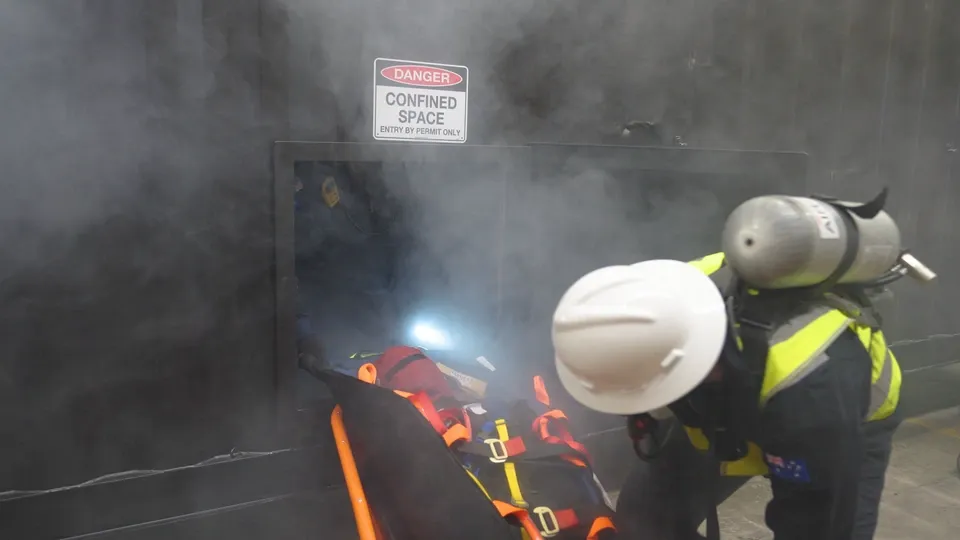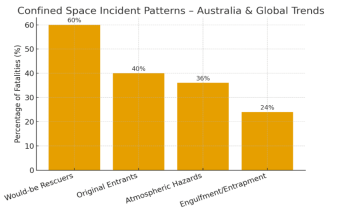Why Preparedness Saves Lives – Confined Space Rescue

Across Australia, confined spaces are part of everyday work. They take many forms—tanks, pits, wells, sewers, silos, tunnels, process vessels and are essential in industries such as oil and gas, mining, construction, agriculture, and water utilities. But while they are routine, they are also some of the most dangerous environments a worker can face.
The hazards of confined spaces are often invisible. A single breath in an oxygen-deficient atmosphere can incapacitate. A sudden release of gas can overwhelm or ignite. Loose material can engulf without warning. Add restricted access and complex geometry, and what might be a minor incident in open air quickly becomes life-threatening underground or inside a vessel.

The Hidden Danger: Why Rescuers Are Most at Risk
Confined space emergencies escalate fast—and often claim the lives of those trying to help.
According to Safe Work Australia, around 60% of confined-space fatalities involve would-be rescuers. These are co-workers who act on instinct, rushing in without the right training or equipment, only to be overcome themselves. In moments, one emergency becomes two—or worse.
Legal and Safety Requirements for Confined Space Entry
Australian law makes the importance of confined space rescue training clear.
The Work Health and Safety Regulation 2011 (Part 4.3) requires PCBUs to:
-
Identify confined spaces
-
Assess and control risks
-
Implement permit systems
-
Isolate hazards
-
Maintain documented and rehearsed rescue procedures
The Model Code of Practice: Confined Spaces (2024) also states that relying only on external emergency services is not acceptable—rescue must be possible on site.
The Australian Standard AS 2865:2009 provides the technical foundation, outlining the need for trained observers, rescue equipment, and competency.
Together, these requirements make one thing clear: no confined-space entry is safe without trained personnel and a practiced rescue plan.
From Compliance to Capability: Building Real Rescue Readiness
Preparedness goes beyond ticking boxes.
An effective rescue system must be realistic, practical, and proven through rehearsal. Workers should be able to:
-
Monitor and test atmospheres
-
Use breathing apparatus (SCBA) confidently
-
Package and retrieve casualties safely
-
Coordinate under pressure
-
Operate essential rescue equipment like tripods, winches, gas detectors, and ventilation systems
Plans on paper don’t save lives — competence and practice do.
Learning from Tragedy
Many incidents share the same heartbreaking pattern:
A worker collapses due to oxygen deficiency. A colleague enters, unprotected, to help—and within seconds, both are lost.
These tragedies are 100% preventable with proper training, equipment, and planning.
Training transforms instinctive, dangerous responses into structured, effective action that saves lives.
AWCC – Delivering Confined Space Rescue Training That Saves Lives
At the Australian Well Control Centre (AWCC), we believe confined space rescue training is more than a regulatory requirement—it’s a moral responsibility.
As a Registered Training Organisation (RTO 41356), AWCC helps industry turn compliance into capability.
Our programs feature:
-
Realistic rescue simulations and purpose-built training rigs
-
Alignment with WHS law and AS 2865
-
Skilled trainers with real industry experience
We ensure every participant leaves with both confidence and competence—ready to act safely and effectively in a confined space emergency.
Be Ready, Be Trained
Confined space rescue is about more than safety—it’s about protecting lives, sustaining industries, and preventing tragedies before they occur.
Because when every second matters, it isn’t instinct that saves lives.
It’s preparation, training, and practice.
Learn more about our nationally recognised Confined Space Rescue Course here.
Leave a Reply